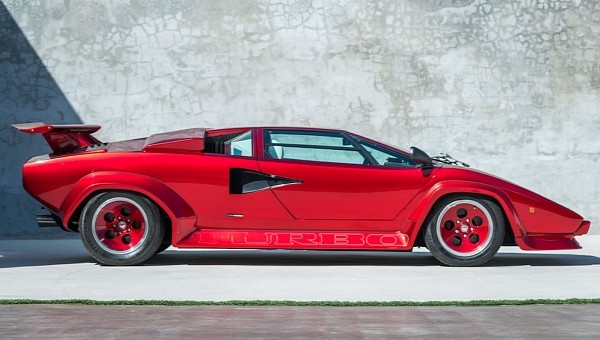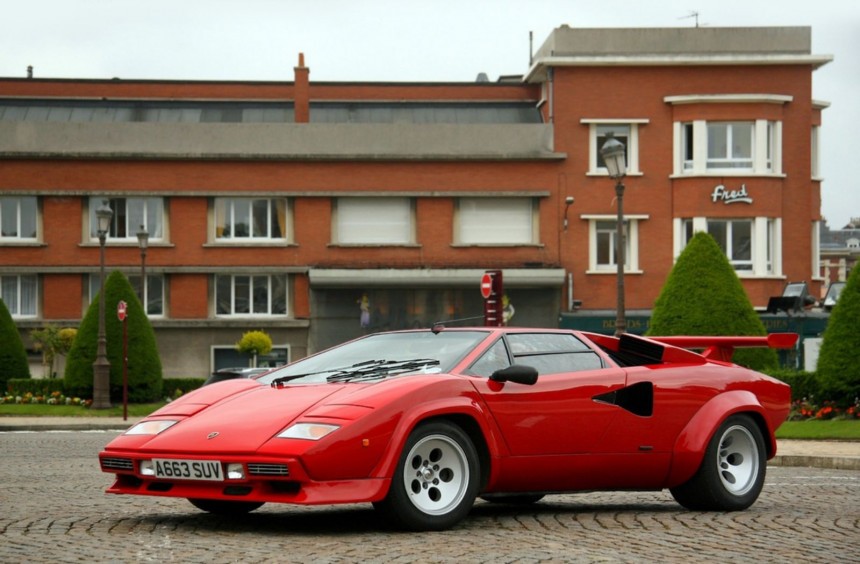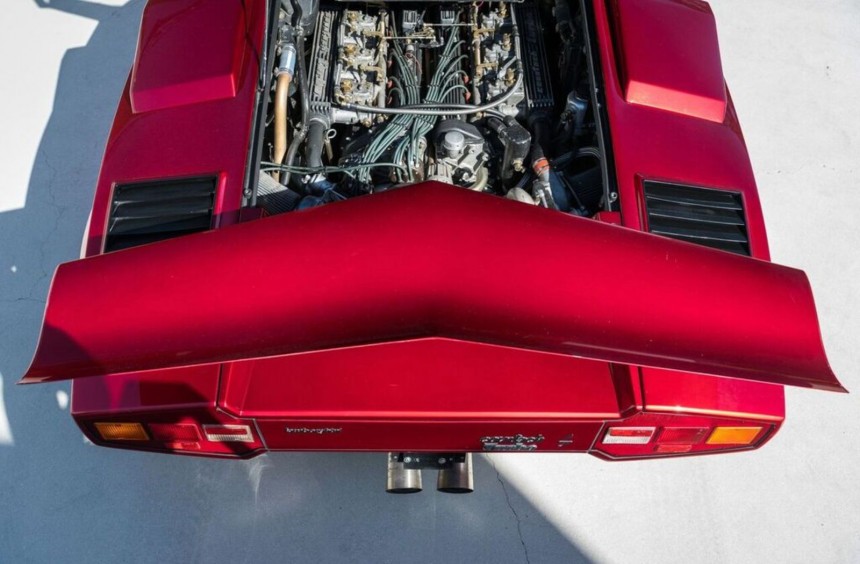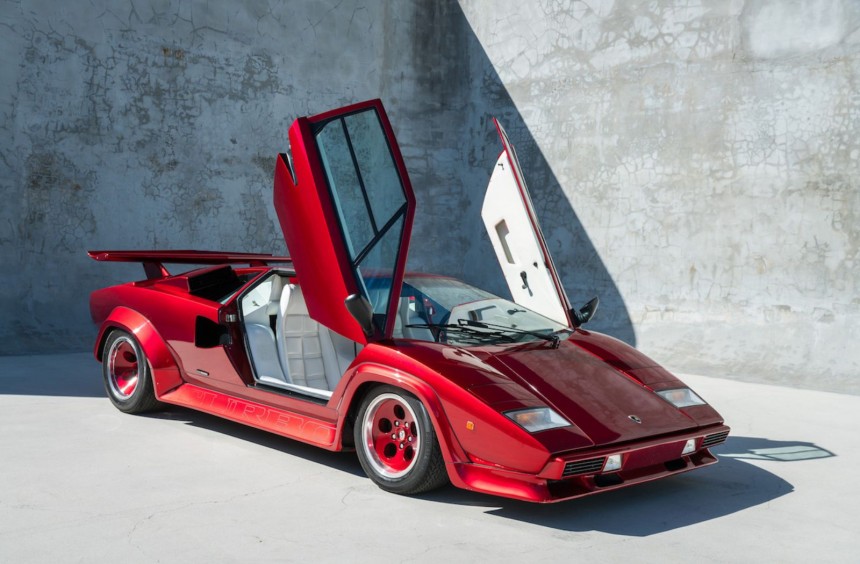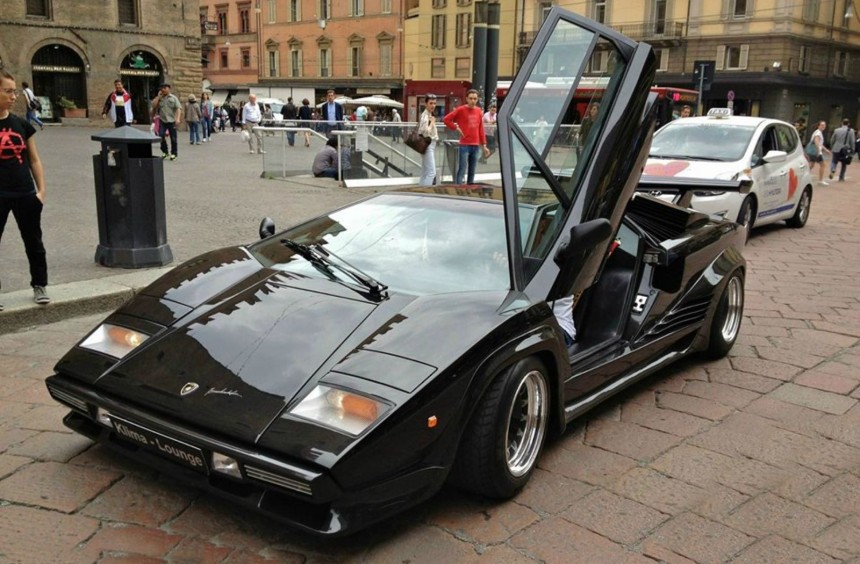Long before the Urus became both Lamborghini’s first SUV and its first turbo-powered model, a Swiss dealer installed a pair of snails in the engine bay of his Countach. With nearly 750 hp on tap, it was one of the most powerful road-legal supercars of the 1980s.
Unveiled to the public in prototype form 52 years ago and unleashed on public roads three years later, the Lamborghini Countach became a timeless supercar icon, mainly because of its wild appearance.
Designed by Bertone’s Marcello Gandini, the new supercar resembled a spaceship. Its body was a collection of aggressive lines that made it unique among the era’s supercars while the scissor-opening doors blew people’s minds and became a defining feature for every Lambo flagship built ever since.
When it came to performance, the first production version of the Countach dubbed LP400 wasn’t all that mind-blowing. Like its predecessor, the Miura, it came with a mid-mounted V12, but the naturally-aspirated unit initially designed by the legendary Giotto Bizzarrini received no major improvements. Displacing 3.9 liters and producing 380 hp, it was basically the same unit found in the Miura P400 SV.
Although the 3.9-liter made the P400 SV the fastest, most powerful iteration of Lamborghini’s first mid-engine supercar, enthusiasts expected more from the newer (and heavier) model. Something along the lines of the bespoke 440-hp, 5.0-liter at the heart of the LP500 prototype first shown at the Geneva Motor Show in 1971.
After its official debut, engineers continued to develop the Countach, launching a couple of improved versions (LP400 S and LP500 S) during the following decade, but, even if the engine displacement and torque output rose, neither version came with an increase in horsepower.
This finally changed in 1985 when the naturally-aspirated engine received another revamp. Enlarged again, this time to 5.2 liters, it had a new cylinder head with four valves per cylinder, used six Webber carbs (in the Euro-spec cars), and could now make 449 horses (455 ps).
The Countach that initially used this engine and became the most powerful production version of them all was called LP5000 Quattrovalvole (four-valve), but the 5.2-liter was also carried over to the visually-enhanced 25th Anniversary Edition launched in 1988.
Before Lamborghini introduced the four-valve version of the iconic twelve-cylinder, which improved overall output, the brand’s most influential clients and some engineers began campaigning for forced induction.
During the first part of the 1980s, turbocharging became the norm in motorsport, so it was seen as the perfect solution for ample power gains without having to extensively modify the engine’s architecture. The manufacturer’s management and leading engineers though, wanted to preserve the tradition of using naturally-aspirated engines, so the idea of turbocharging the Countach was never put into practice by the factory.
Thankfully, that decision didn’t stop one enthusiast from turning the dream of a turbocharged Countach into reality. His name was Max Bobnar, and he was one of the most influential Lamborghini dealers in Europe, managing the company’s operations in Switzerland.
Bobnar was one of those enthusiasts who campaign for a turbo Lambo, but after failing to convince the carmaker’s management to build such a car, he decided to have not one but two built for himself.
As I mentioned earlier, Lamborghini followed up on the first LP400 with several improved versions over the years. The first was the LP400 S which came with visual enhancements, but its engine was toned down to 350 hp (355 ps).
In 1980, Bobnar bought an LP400 S for himself and two years later, he enlisted engineer Franz Albert to help make it more exciting. Famous for his work as chief engineer of Germany’s tuning house Koenig-Specials where he adapted a pair of Rajay aircraft turbos to Ferrari’s flat-twelve, Albert employed the same recipe for the Countach’s underpowered V12.
Unlike the second car which we’ll talk about next, there is little information about the first one. Thus, we don’t know exactly what other modifications the 3.9-liter engine received or how many horses it made. But it’s safe to assume the figure stood around the 700-hp mark.
Fitted with new wheels, enhanced side skirts, and repainted in a flashy coat of metallic red paint, Bobnar’s first twin-turbo Countach was eventually sold. For years, historians assumed it was destroyed in a crash but, John Temerian, the founder of Curated and a Lamborghini fanatic found out the car had survived. You can learn more about the epic find from John himself in the YouTube video below.
Lamborghini’s third official Countach iteration, the LP500 S was introduced in 1982 with an enlarged, 4.9-liter version of the V12 that brought power back to 370 hp (375 ps) and also improved torque output to 308 lb-ft (418 Nm) – the highest torque figure until the introduction of the Quattrovalvole.
By 1984, Max Bobnar had sold his first twin-turbo Countach and decided he needed another one. Using a newer LP500 S that was initially yellow, Franz Albert was called upon again to work his magic.
This car is well-documented, so we know for sure that Albert did not alter the engine’s bore and stroke (85.5 x 96 mm), but lowered compression from 9.2:1 to 7.2:1 and swapped the Weber 45 DCOE carbs with 40 DCOE units. Then, he followed the same winning formula of installing a Rajay EF60 snail with a charge-air intercooler on each bank of cylinders, giving birth to another twin-turbo monster. At full boost (1.5 bar), the engine made 748 hp and 646 lb-ft (876 Nm) of torque – twice as much as it did in naturally-aspirated guise.
It’s also documented that the 5-speed transmission’s gear ratios were altered to deal with the increase in power and make the car as quick as possible. Tested by automotive magazines on several occasions, the twin-turbo LP500 S could sprint from 0 to 62 mph (100 kph) in a blistering 3.6 seconds, which made it one of the most powerful supercars on the planet back in the mid-1980s. A top-speed test never occurred but judging by the bespoke speedometer, which peaked at 425 kph (264 mph), it was deadly fast.
As with the first car, Bobnar had the second twin-turbo Countach customized, then sold it. It was repainted black, given a set of lightweight Ronal wheels and the black leather-upholstered seats were contrasted by race-spec Britax four-point harnesses. Records show that it changed owners at least a couple of times before being bought by a Lamborghini collector in Germany who still owns it today.
Although forgotten by many, these twin-turbo cars remain two of the most legendary members of the Countach lineage. Although they weren’t modified in Italy, both are recognized by the manufacturer as part of the model’s sixteen-year history.
Designed by Bertone’s Marcello Gandini, the new supercar resembled a spaceship. Its body was a collection of aggressive lines that made it unique among the era’s supercars while the scissor-opening doors blew people’s minds and became a defining feature for every Lambo flagship built ever since.
When it came to performance, the first production version of the Countach dubbed LP400 wasn’t all that mind-blowing. Like its predecessor, the Miura, it came with a mid-mounted V12, but the naturally-aspirated unit initially designed by the legendary Giotto Bizzarrini received no major improvements. Displacing 3.9 liters and producing 380 hp, it was basically the same unit found in the Miura P400 SV.
The most powerful production versions
After its official debut, engineers continued to develop the Countach, launching a couple of improved versions (LP400 S and LP500 S) during the following decade, but, even if the engine displacement and torque output rose, neither version came with an increase in horsepower.
This finally changed in 1985 when the naturally-aspirated engine received another revamp. Enlarged again, this time to 5.2 liters, it had a new cylinder head with four valves per cylinder, used six Webber carbs (in the Euro-spec cars), and could now make 449 horses (455 ps).
The Countach that initially used this engine and became the most powerful production version of them all was called LP5000 Quattrovalvole (four-valve), but the 5.2-liter was also carried over to the visually-enhanced 25th Anniversary Edition launched in 1988.
The dream of a turbocharged Countach
During the first part of the 1980s, turbocharging became the norm in motorsport, so it was seen as the perfect solution for ample power gains without having to extensively modify the engine’s architecture. The manufacturer’s management and leading engineers though, wanted to preserve the tradition of using naturally-aspirated engines, so the idea of turbocharging the Countach was never put into practice by the factory.
Thankfully, that decision didn’t stop one enthusiast from turning the dream of a turbocharged Countach into reality. His name was Max Bobnar, and he was one of the most influential Lamborghini dealers in Europe, managing the company’s operations in Switzerland.
Bobnar was one of those enthusiasts who campaign for a turbo Lambo, but after failing to convince the carmaker’s management to build such a car, he decided to have not one but two built for himself.
The first car: a metallic red LP400 S
In 1980, Bobnar bought an LP400 S for himself and two years later, he enlisted engineer Franz Albert to help make it more exciting. Famous for his work as chief engineer of Germany’s tuning house Koenig-Specials where he adapted a pair of Rajay aircraft turbos to Ferrari’s flat-twelve, Albert employed the same recipe for the Countach’s underpowered V12.
Unlike the second car which we’ll talk about next, there is little information about the first one. Thus, we don’t know exactly what other modifications the 3.9-liter engine received or how many horses it made. But it’s safe to assume the figure stood around the 700-hp mark.
Fitted with new wheels, enhanced side skirts, and repainted in a flashy coat of metallic red paint, Bobnar’s first twin-turbo Countach was eventually sold. For years, historians assumed it was destroyed in a crash but, John Temerian, the founder of Curated and a Lamborghini fanatic found out the car had survived. You can learn more about the epic find from John himself in the YouTube video below.
The second car: an all-black LP500 S
By 1984, Max Bobnar had sold his first twin-turbo Countach and decided he needed another one. Using a newer LP500 S that was initially yellow, Franz Albert was called upon again to work his magic.
This car is well-documented, so we know for sure that Albert did not alter the engine’s bore and stroke (85.5 x 96 mm), but lowered compression from 9.2:1 to 7.2:1 and swapped the Weber 45 DCOE carbs with 40 DCOE units. Then, he followed the same winning formula of installing a Rajay EF60 snail with a charge-air intercooler on each bank of cylinders, giving birth to another twin-turbo monster. At full boost (1.5 bar), the engine made 748 hp and 646 lb-ft (876 Nm) of torque – twice as much as it did in naturally-aspirated guise.
It’s also documented that the 5-speed transmission’s gear ratios were altered to deal with the increase in power and make the car as quick as possible. Tested by automotive magazines on several occasions, the twin-turbo LP500 S could sprint from 0 to 62 mph (100 kph) in a blistering 3.6 seconds, which made it one of the most powerful supercars on the planet back in the mid-1980s. A top-speed test never occurred but judging by the bespoke speedometer, which peaked at 425 kph (264 mph), it was deadly fast.
As with the first car, Bobnar had the second twin-turbo Countach customized, then sold it. It was repainted black, given a set of lightweight Ronal wheels and the black leather-upholstered seats were contrasted by race-spec Britax four-point harnesses. Records show that it changed owners at least a couple of times before being bought by a Lamborghini collector in Germany who still owns it today.
Although forgotten by many, these twin-turbo cars remain two of the most legendary members of the Countach lineage. Although they weren’t modified in Italy, both are recognized by the manufacturer as part of the model’s sixteen-year history.
